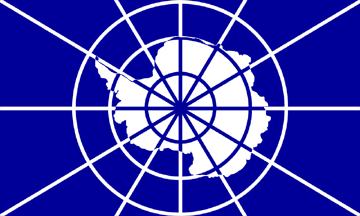
Last modified: 2009-09-12 by antónio martins
Keywords: south pole | map |
Links: FOTW homepage |
search |
disclaimer and copyright |
write us |
mirrors
Flag of Antarctica, as proposed by the Treaty Secretariate

This is the flag of the Antarctic Treaty used by the permanent
Antarctic Treaty Secretariat (ATS); its headquarters are in Buenos Aires.
This flag can also be used by the countries which joined the treaty and
hoist the annual CPAT meetings (28 states with statute of consultative
parties and 17 more as non consultative). The ATS has international
juridical personality.
Michel Sicard, 16 Nov 2006
The use of this flag results from article 7 of headquarter agreement
negotiated with Argentina.
The flag is derived from the ATS emblem adopted in Warsaw (25th CPAT
10/20 September 2002) by decision number 2 of 20th September 2002.
This flag represents the outlined map of the Antarctic continent in
white on a navy blue (pantone 295C) background with the main latitude
and longitudinal lines superposed.
Michel Sicard, 16 Nov 2006
There’s now solid evidence that this is adopted as the
«Emblem »(and flag)« of the Antarctic» by the Treaty
Organization, it is not just the Organization’s own emblem/flag.
António Martins, 19 Jan 2007
At the intiative of the United Kingdom, Working Paper (XXV ATCM/WP5), Decision 2 (2002) was adopted:
Emblem of the Antarctic Treaty
Decide:
- Desiring to provide a clear identity to the work of the ATCM and its Secretariat;
- Conscious that there exists a design traditionally employed by the Antarctic Treaty parties to identify their work, but that the design has no formal status;
- Believing that the adoption of such a design would enhance presentationally the work of the ATCM and its Secretariat when located in Buenos Aires;
- That the design annexed to this Decision shall constitute the formal emblem of the Antarctic Treaty.
- That it may be used by:
- The Secretariat of the Antarctic Treaty;
- The host state of the ATCM or Special ATCM in the period of preparation for and during a Consultative Meeting;
- By any other Consultative Party when hosting other meetings under the auspices of the Antarctic Treaty of its Environmental Protocol;
- By others with the authority of the ATCM.
- That the design shall be shown on the official Reports of the ATCM and may be employed at the premises of the Antarctic Treaty Secretariat, on its official means of transport, as well as on stationary, electronic communications, reports, flags, signs, etc.
Sources:
quoted by Phil Nelson, 24 Nov 2006, and Colin Dobson, 18 Jan 2007
The flag of Antarctic. RGB : 000-051-102. CMYK : 100-56-0-34.
Pantone: 295C. Source: Michel Sicard (SFV)
Arnaud Leroy, 18 Jan 2007
There is a pdf of the actual emblem
on line.
I wonder if the lines extend all the
way to the edges of the actual flag, though, as it is not quite possible
to see in the Swedish photograph, which incidentally, is either the
wrong way around or upside down.
Colin Dobson, 18 Jan 2007
It seems to be 3:5 with the 60° and 120° meridians doubling
as diagonals. The stripes on the flag (as seen in the
two
photos
on line at the
28th
ATCM in Stockholm from 6 to 17 june 2005) are much thicker than those in
the official document on line.
António Martins, 19 Jan 2007
Please note, this is the same emblem which appears in the above referenced
source as Annex B and is thus the official or “formal emblem”
of the ATCM, as the decision states. There are differences, incorporating
some artistic licence, however, in the manner in which the emblem is used,
noticeably in the black and white version which appears on many ATCM reports
and on the web site of the ATS itself.
Colin Dobson, 18 Jan 2007
Anything below this line was not added by the editor of this page.